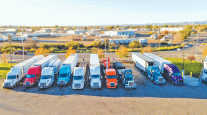Staff Reporter
CES Panel Discusses Supply Chain Problems

[Stay on top of transportation news: Get TTNews in your inbox.]
LAS VEGAS — Data and technology are playing a crucial role in addressing the supply chain crunch in the transportation space, experts said during a CES 2022 panel discussion.
Much of the Jan. 5 discussion focused on how to best utilize and share data to address challenges that have snared the supply chain.
“The good news is there is tons of data out there,” said Steve Schmith, director of automotive strategy at data management firm Acxiom. “The challenges that companies are trying to understand when it comes to that data is how to use it and how to aggregate it — not only in ways that are gleaning insight, but also in ways that are ethical and compliant with various regulations.”
Schmith noted that various industries are showing more willingness to partner and share information as business silos progressively blur. “Historically a lot of these data points have been in very siloed organizations,” he said.
Schmith believes the automotive supply chain sits at a key inflection point given trends such as the semiconductor chip shortage and push toward electric vehicles; in particular, with rising competition for limited supplies of items such as chips and lithium-ion batteries.
“We’re finding ourselves in a situation of not only how do we create a supply chain that’s going to meet consumer demand, but how do we do so when all of these other industries are also vying for these components,” Schmith said. “And the very finite set of suppliers that are providing them.”
There also is the balance of protecting proprietary information while cooperating on shared challenges, noted Finch Fulton, vice president of policy and strategy at automated platooning developer Locomation. In particular, he said when companies need to buy certain types of materials or components, they may not want competitors to use that information to prevent those purchases.
“There’s no agreement on common data specifications for these shortages in the supply chain,” he said. “There is data out there, but is it the right type of data for the types of questions people are asking.”
Fulton does, however, note that there’s a bipartisan political push to address the supply chain challenges in transportation.

Fulton
“If you look specifically at trucking, there’s a big push,” Fulton said. “Different administrations have tried to take a crack [at] how can you provide more transparency on some of that downtime and supply chain holdups.”
Beyond components, Fulton argued data can be mined to help carriers improve the quality of life for drivers and, by extension, address the industry’s ongoing driver shortage.
“You can start addressing issues around driver pay and getting drivers home to address the loneliness, depression, all of the health issues that come with that,” he said. “That’s how you can stop that flood of people that leave truck driving as an industry, and that’s how you take care of the supply chain issues that come from the lack of trucks.”

Schmith
On the developmental front, Schmith noted the cloud, artificial intelligence and machine learning can allow for new ways to share data and address supply chain bottlenecks. Digital twinning, for instance, is the process of creating a computer model of something like a truck to better share information about it. This type of technology could help the industry move toward a made-to-order model for vehicles, which could reduce strain on components and allows for more customization.
“It’s not only from a perspective of using these industry 4.0 types of technology to design faster and build faster,” Schmith said. “From an OEM perspective, there are some very good examples out there of companies that are looking at it, from the design process, to the delivery, to the customer experience perspective.”
Want more news? Listen to today's daily briefing below or go here for more info:




